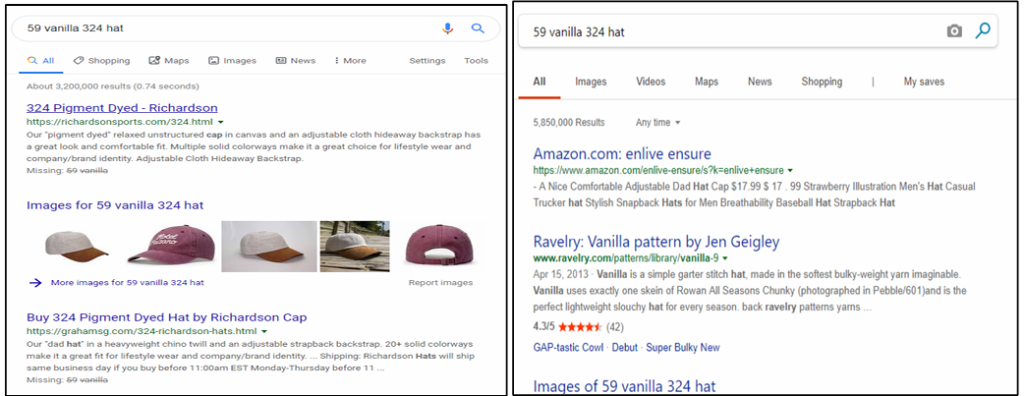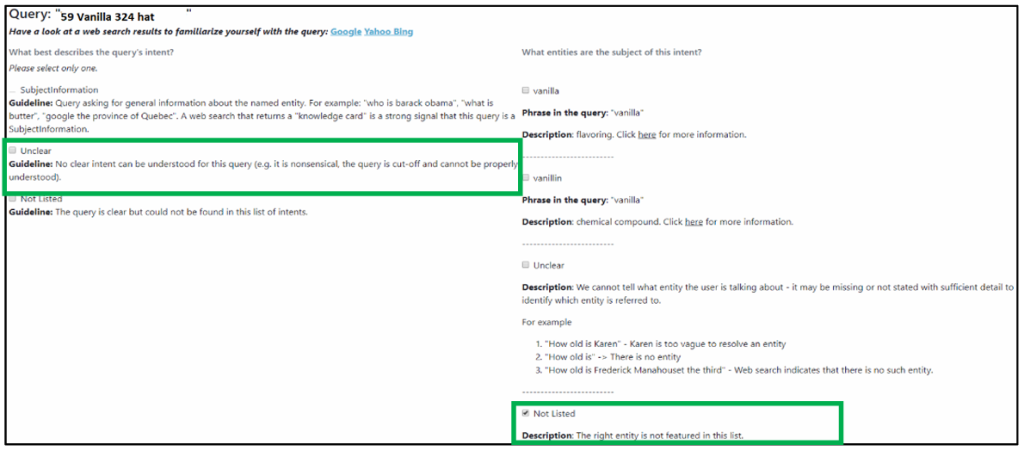The goal of this document is to assist you in your rating of the task Entity Intent. We will provide a step
by step approach to this task.
When reviewing this type of task, there are several key areas you will be asked to identify:
You will be asked:
- Query Intent: What does the User want to know?
- What Entity do They want to know it About? *Be as specific as possible
- Query Features
a. Yes/No Answer
b. Counting Intent Results
c. Time Period Intent
i. In a Particular Year
ii. Comments - Query Checkà Intent + Subject Entity = Query.
*Please note the key to your success in this task, is to conduct as much research as possible. Since theseare queries submitted by users, they may contain poor grammar and misspellings. Please utilize variousresearch tools such as speaking the query into a smart assistant and/or multiple search engines, or yourknowledge on the entity
Example 1: Query: “tell me what’s in a manhattan”

When approaching these queries, we want to get an overall view of what is requested of us. Here we are asked for “tell me what’s in manhattan”, it appears they are asking for the content of either a meal or drink. We want to glance over the overall task, we want to also look at selections are being offered.
In this case there are options such as a city and a cocktail. These are all feasible, as the query may “contain grammatical or spelling errors.
Step 1: Identifying the Query Intent: What does the User want to know?
Here we will begin our online research to determine what is meant by “tell me what’s in a manhattan” We will insert the exact terms in two different search engines, to identify what the query intent is.

Answer: Through multiple search engines, it is found that an overwhelming result point the cocktail, manhattan. Therefore, the correct result for the query’s intent, is Not Listed, as this query is asking for the ingredients of this cocktail manhattan.
Step 2: What Entity do They want to know it About?
Answer: In this section we want to be as specific as possible to the entity presented in the query. In this case we want to know what the ingredients, are for the subject entity Manhattan. In this specific example it would be Manhattan- cocktail made with whiskey, sweet vermouth, and bitters. We clicked on the above subject entity, and the
page refers to and describes one entity.
Verifying Link:

Guideline Reference: Section 3 “You must choose the most choose the most precise entity from a list of options associated with the phrases from the query. The task is to pick the single most plausible intent.
3: Query Features
a. Yes/No Answer – We would not select this option, as this query requires more than a simple yes/no answer.
b. Counting Intent Results – Does not apply to this query.
c. Time Period Intent
i.In a Particular Year – Does not apply to this query
ii.Comments – Does not apply to this query
Final Rating. Comments: The query is asking for the ingredients of the cocktail Manhattan, which is not listed.

When we select Not Listed for the Query Intent, we must select Not listed for the Subject Entity even it the entity is listed.
Example 2: Query: “are there any carbohydrates in shrimp”

Here we are asked for “are there any carbohydrates in shrimp”, it appears they are asking for the
carbohydrate content in shrimp.
Step 1: Identifying the Query Intent: What does the User want to know?
Here we will begin our online research to determine what is meant by “are there any carbohydrates in shrimp” We will insert the exact terms in an online search engines, to
identify what the query intent is.
Answer: The user is looking for the carbscontent of the seafood dish shrimp.

Step 2: What Entity do They want to know it About?
Answer: In this section we want to be as specific as possible to the entity presented in the query. In this case we want to know what the carbohydrate content of shrimp. We
clicked on the above subject entity, and the page refers to and describes one entity. We want to make sure that the link is within the description to ensure the content describes the subject entity. * Note there was a similar link listed under the term “shrimp” upon click on this link. In this case we want to select the single most plausible intent, which is the seafood.
Guideline Reference: Section 3 “You must choose the most choose the most precise entity from a list of options associated with the phrases from the query. The task is to pick the single most plausible intent.

- Query Features
a. Yes/No Answer – We would not select this option, as this query requires more than a simple yes/no answer.
b. Counting Intent Results – Does not apply to this query.
c. Time Period Intent
i. In a Particular Year – Does not apply to this query
ii. Comments – Does not apply to this query
Final Rating. Comments: No Comments required.

Example 3 Query: “59Vanilla 324 hat”

Here we are asked for “59Vanilla 324 hat”
Step 1: Identifying the Query Intent: What does the User want to know?
Here we will begin our online research to determine what is meant by “59Vanilla 324 hat” We will insert the exact terms in an online search engine, to identify what the
query intent is.
Answer: We performed an online research, and there is no clear understanding of the query. There we would select Unclear and Not listed for Subject Entities.

Final Rating: Comments: After performing online research through multiple search engines it is unclear what the user intent is.
